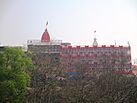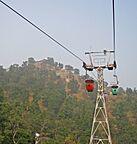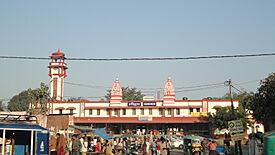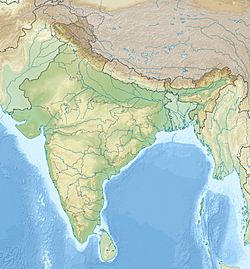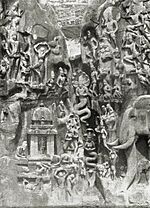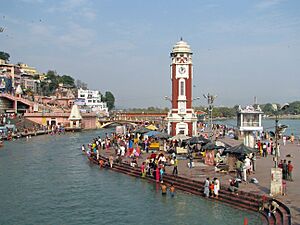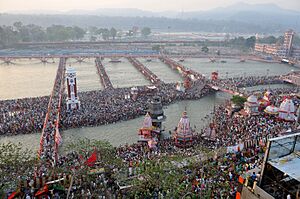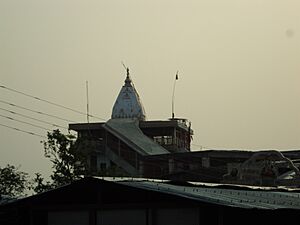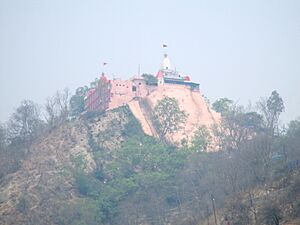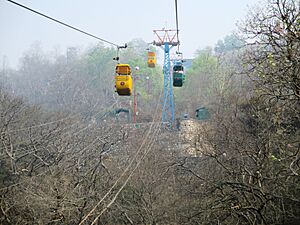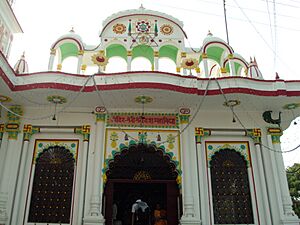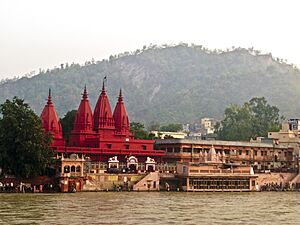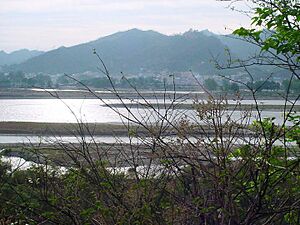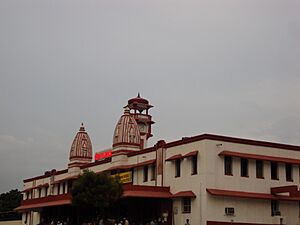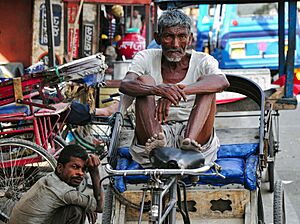Haridwar facts for kids
Haridwar (pronounced `hʌrɪˈdwɑr`), once known as Mayapuri, is a vibrant city in Uttarakhand, India. It's located on the right bank of the Ganges river, right where the mighty river leaves the mountains and flows into the flat plains. Haridwar is considered a very holy place for Hindus. It's famous for hosting huge religious events like the Kumbha Mela, which happens every 12 years. During this festival, millions of people gather to bathe in the Ganges, believing it washes away sins and helps them achieve moksha (spiritual freedom).
Legend says that Haridwar is one of four places where drops of amrita (the drink of immortality) accidentally spilled from a pitcher carried by the celestial bird Garuda. The spot where this happened, called Brahma Kund at Har ki Pauri, is considered the most sacred bathing spot. Haridwar is also a starting point for the Kanwar Yatra, a pilgrimage where people carry sacred Ganges water to offer to Shiva temples. Beyond its religious importance, Haridwar is also growing with new industries and educational centers. It's a place where ancient traditions meet modern development.
Quick facts for kids
Haridwar
Mayapuri
|
|
|---|---|
|
Clockwise from top:
Evening view of Har Ki Pauri, Chandi Devi Temple, Ropeway to Chandi Devi, view of the Ganga River, Haridwar railway station, Ganga Aarti at Har Ki Pauri, Shiv Murti during sunset and the Mansa Devi Temple. |
|
| Country | |
| State | Uttarakhand |
| District | Haridwar |
| Municipality | 1868 |
| Government | |
| • Type | Mayor–Council |
| • Body | Haridwar Municipal Corporation |
| Area | |
| • City | 105 km2 (41 sq mi) |
| Elevation | 314 m (1,030 ft) |
| Population
(2011)
|
228,832 |
| • Metro | 231,338 |
| Languages | |
| • Official | Hindi |
| • Native | Khariboli |
| Time zone | UTC+5:30 (IST) |
| PIN |
249401
|
| Telephone code | +91-1334 |
| Vehicle registration | UK-08 |
| Sex ratio | 1.18 ♂/♀ |
Contents
- What's in a Name? The Meaning of Haridwar
- A Glimpse into Haridwar's Past
- Geography and Climate of Haridwar
- Haridwar's City Views
- People of Haridwar
- Sacred Sites and Temples
- Har Ki Pauri: The Lord's Footsteps
- Chandi Devi Temple: Goddess on the Hill
- Mansa Devi Temple: Fulfilling Wishes
- Maya Devi Temple: The City's Protector
- Kankhal: A Place of Legends
- Bharat Mata Mandir: Mother India Temple
- Piran Kaliyar: A Sufi Shrine
- Neel Dhara Pakshi Vihar: Bird Watcher's Paradise
- Other Temples and Ashrams
- Top Educational Institutions
- Important Areas in Haridwar
- Getting Around Haridwar
- Industry in Haridwar
- Notable People from Haridwar
- Images for kids
- See also
What's in a Name? The Meaning of Haridwar
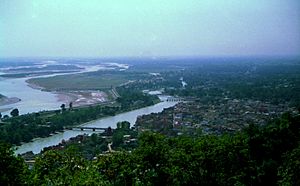
The name Haridwar has two main meanings. In Sanskrit, an ancient Indian language, Hari means "Vishnu" (a Hindu god), and dvāra means "gateway." So, Haridwar means "The Gateway to Vishnu." This is because it's often the starting point for pilgrims visiting the famous Badrinath Temple, which is dedicated to Vishnu.
Another spelling, Hardwar, uses Hara, which means "Shiva" (another Hindu god). So, Hardwar can mean "Gateway to Shiva." This name is used because it's also a common starting point for journeys to places like Mount Kailash and Kedarnath, which are important for Shiva worshippers.
According to legend, the River Ganga first touched the plains at Haridwar after flowing from the hair of Lord Shiva. This is why the city was also known as Gangadwára, meaning "Gateway of the Ganga."
A Glimpse into Haridwar's Past
Haridwar has a very long history, mentioned in ancient Hindu scriptures by names like Kapilasthana, Gangadvāra, and Mayapuri. It's also known as a gateway to the Char Dham, four important pilgrimage sites in Uttarakhand.
Ancient stories say that the wise Sage Kapila had his ashram (a spiritual retreat) here, giving the city its old name, Kapilasthana. Another legend tells of King Bhagiratha, who performed years of penance to bring the Ganges River down from heaven. He did this to help his ancestors find peace. Even today, many Hindus bring the ashes of their loved ones to Haridwar to immerse them in the Ganges, continuing this tradition.
Haridwar was part of big empires like the Maurya Empire (around 322–185 BCE) and the Kushan Empire (around 1st–3rd centuries CE). We know about its early history from a Chinese traveler named Huan Tsang, who visited in 629 CE. He called the area 'Mo-yu-lo' and mentioned a temple called 'Gangadvara'.
The city also saw the rule of the Delhi Sultanate and was visited by the conqueror Timur Lang in 1399.

In the 16th century, the first Sikh Guru, Guru Nanak, visited Haridwar. His visit is remembered at a place called Gurudwara Nanakwara. Interestingly, families of Hindu priests in Haridwar, known as Pandas, have kept detailed family records for centuries. These records, called Vahis, help people trace their family trees!
During the Mughal Empire, Emperor Akbar was known to drink water from the Ganges, calling it "the water of immortality." Raja Man Singh of Amber is said to have helped build the modern city of Haridwar and improved the bathing steps at Har Ki Pauri.
Haridwar has always been a place of learning. It's famous for Ayurveda (traditional Indian medicine) and has unique schools called Gurukuls. One of the oldest is the Gurukul Kangri Vishwavidyalaya, founded in 1902. Modern development began in the 1960s with the establishment of Bharat Heavy Electricals Limited (BHEL), a large government company.
Geography and Climate of Haridwar
Haridwar is located at the foothills of the Shivalik ranges, where the Ganges river flows out of the mountains and onto the plains. The river water is usually clear and cold, except during the monsoon season when it carries soil from the mountains.
The district of Haridwar is quite green, with a large part covered by forests. The famous Rajaji National Park is located within the district, making it a great place for wildlife lovers. You can enter the park through several gates, some of which are very close to Haridwar.
Haridwar is about 314 m (1,030 ft) above sea level.
Weather in Haridwar
The city experiences hot summers and cool winters.
- Summers: Temperatures range from 25 to 44 °C (77 to 111 °F).
- Winters: Temperatures can drop from 24 °C (75 °F) down to −1 °C (30 °F).
| Climate data for Haridwar | |||||||||||||
|---|---|---|---|---|---|---|---|---|---|---|---|---|---|
| Month | Jan | Feb | Mar | Apr | May | Jun | Jul | Aug | Sep | Oct | Nov | Dec | Year |
| Mean daily maximum °C (°F) | 20 (68) |
22 (72) |
27 (81) |
33 (91) |
36 (97) |
34 (93) |
31 (88) |
30 (86) |
30 (86) |
29 (84) |
26 (79) |
22 (72) |
28 (83) |
| Mean daily minimum °C (°F) | 7 (45) |
9 (48) |
13 (55) |
18 (64) |
21 (70) |
23 (73) |
23 (73) |
23 (73) |
21 (70) |
17 (63) |
11 (52) |
8 (46) |
16 (61) |
| Average precipitation mm (inches) | 72 (2.8) |
76 (3.0) |
78 (3.1) |
55 (2.2) |
113 (4.4) |
296 (11.7) |
599 (23.6) |
568 (22.4) |
301 (11.9) |
102 (4.0) |
23 (0.9) |
91 (3.6) |
2,374 (93.6) |
| Source: Sunmap | |||||||||||||
Haridwar's City Views
People of Haridwar
| Religions in Haridwar City (2011) | ||||
|---|---|---|---|---|
| Religion | Percent | |||
| Hinduism | 82.66% | |||
| Islam | 15.70% | |||
| Christianity | 0.26% | |||
| Jainism | 0.13% | |||
| Others† | 1.2% | |||
| Distribution of religions †Includes Sikhs (1%), Buddhists (<0.2%). |
||||
As of 2011, Haridwar city had a population of 310,562 people. Most of the people living in Haridwar are Hindus (about 82.66%), followed by Muslims (about 15.70%). The city has a good literacy rate of 70%, which is higher than the national average in India.
Sacred Sites and Temples
Haridwar is home to many important religious sites. The five main pilgrimage spots within Haridwar are "Gangadwar" (Har ki Pauri), Kushawart, Bilwa Tirtha (Mansa Devi Temple), and Neel Parvat (Chandi Devi Temple). It's important to know that alcohol and non-vegetarian food are not allowed in Haridwar due to its religious significance.
Har Ki Pauri: The Lord's Footsteps
This famous bathing spot was built by King Vikramaditya in memory of his brother, Bharthari. It's believed that Bharthari meditated here. The most sacred part of Har Ki Pauri is Brahmakund. Every evening, a beautiful prayer ceremony called Aarti is offered to Goddess Ganga. It's a stunning sight with lights and sounds, and many visitors come to witness it. After the ceremony, people float small lamps and flowers on the river as offerings.
Chandi Devi Temple: Goddess on the Hill
This temple is dedicated to Goddess Chandi and is located on top of the 'Neel Parvat' hill. It was built in 1929. Legend says that Goddess Chandi defeated two demons, Chanda and Munda, here, which gave the place its name. You can reach the temple by trekking about 3 km (1.9 mi) or by taking a fun ropeway ride.
Mansa Devi Temple: Fulfilling Wishes
The temple of Goddess Mansa Devi is on top of the Bilva Parvat. Her name means 'Goddess fulfilling desires'. Many tourists visit this temple, especially for the mountain cable cars that offer amazing views of the city. Inside, there are two idols of the Goddess.
Maya Devi Temple: The City's Protector
Haridwar was once known as Mayapuri because of Goddess Maya Devi. This ancient temple, dating back to the 11th century, is dedicated to Maya Devi, the city's protector goddess. It's believed to be one of the places where parts of Goddess Sati's body fell.
Kankhal: A Place of Legends
The ancient Daksha Mahadev Temple is in the town of Kankhal. Hindu stories tell that King Daksha, father of Shiva's first wife Sati, held a special ceremony and purposely didn't invite Shiva. Sati, feeling insulted, ended her life. Shiva, in his anger, created Virabhadra, who killed King Daksha. Later, Shiva brought Daksha back to life, giving him a goat's head. This temple honors that legend.
Bharat Mata Mandir: Mother India Temple
The Bharat Mata Mandir is a unique, multi-story temple dedicated to Bharat Mata (Mother India). It was opened in 1983. This tall, eight-story temple shows different periods of Indian history on each floor, from ancient times to India's independence. It celebrates India's heroes, important women, and saints from various religions like Jainism, Sikhism, and Buddhism.
Piran Kaliyar: A Sufi Shrine
Piran Kaliyar Sharif is a famous shrine built by Ibrahim Lodhi, a ruler of Delhi. It honors Hazrat Alauddin Sabir Kaliyari, a 13th-century Sufi Saint. People from all over the world visit this shrine, especially during the annual 'Urs' festival.
Neel Dhara Pakshi Vihar: Bird Watcher's Paradise
About 3.5 km (2.2 mi) from the railway station, Neel Dhara Pakshi Vihar is a great spot for bird watching. It's located at the Bhimgoda Barrage on the Ganges River. This area is known for different kinds of migratory birds, including Siberian Cranes, which can be seen in winter. It's also a popular spot for nature lovers and trekkers, offering views of the Shivalik Hills.
Other Temples and Ashrams
- Dudhadhari Barfani Temple: Made of white marble, this temple honors Rama-Sita and Hanumana.
- Sureshvari Devi Temple: Dedicated to Goddess Sureshwari, it's inside Rajaji National Park and requires permission to visit.
- Pawan Dham: A modern temple built entirely with glass pieces.
- Tirupati Balaji Mandir: A sacred temple built in the South-Indian style, dedicated to both Vishnu and Shiva.
- Sapt Rishi Ashram: A meditation and yoga center near the Ganges, believed to be where seven ancient sages meditated. The Ganges river is said to have split into seven streams here to avoid disturbing them.
- Harihar Ashram: Located in Kankhal, it has a special Mercury Shivalinga weighing about 150 kg.
- Shantikunj: The headquarters of a spiritual organization, it's a place for spiritual guidance and attracts many tourists.
- Shri Chintamani Parshwnath Jain Shwetambar Mandir: A beautiful Jain temple built in 1990 with Jaisalmer stone.
- Patanjali Yogpeeth: A large yoga institution and research center founded by Swami Ramdev, where thousands come for yoga and wellness.
Top Educational Institutions
Haridwar is also a hub for education, with several well-known institutions.
Acharyakulam
Located on the Haridwar-Delhi highway, this is a residential school that opened in 2013 and is part of the Patanjali group.
Gurukul Kangri University
Situated in Kankhal by the Ganges, Gurukul Kangri University is one of India's oldest universities, founded in 1902. It teaches ancient Vedic and Sanskrit literature, Ayurveda, and philosophy, alongside modern sciences. Its museum has rare artifacts from the Indus Valley civilisation. Mahatma Gandhi visited this campus multiple times.
Dev Sanskriti Vishwavidyalaya
Established in 2002, this is a fully residential university run by the Shri Vedmata Gayatri Trust. It offers courses in Yogic Science, Indian Culture, Tourism, and more.
Uttarakhand Sanskrit University
This university focuses on studying ancient Sanskrit scriptures, Hindu rituals, and traditions. Its building is inspired by ancient Hindu architecture.
Other Colleges and Schools
- Chinmaya Degree College: A science college in Shivalik Nagar.
- HEC PG College: Offers undergraduate and postgraduate courses in commerce, management, science, and arts.
- Sheel Institute: A computer institute in Shivalik Nagar.
- There are also two State Ayurvedic Colleges: Rishikul State Ayurvedic College and Gurukul Ayurvedic College.
- Notable schools include Delhi Public School, Kendriya Vidyalaya, and DAV Central Public School.
Important Areas in Haridwar
- B.H.E.L., Ranipur Township: This is a large campus of Bharat Heavy Electricals Limited, a major government company. It has factories and provides homes, schools, and medical facilities for its employees.
- Bahadrabad: Located on the Haridwar–Delhi National Highway, it's home to the Bhimgoda Barrage, which helps with irrigation.
- SIDCUL: A huge industrial area developed by the state government. Many big companies like ITC and Hindustan Unilever Limited have set up factories here, making it an important industrial hub.
- Jwalapur: An old part of the city that has become a key trading and shopping center. It has a history dating back to the 1700s.
- Cheela Dam: A nice picnic spot with a dam and a man-made lake, where you might even spot elephants and other wild animals.
- Shivalik Nagar: One of the newest and largest residential areas, it has grown rapidly due to its closeness to the industrial areas.
Getting Around Haridwar
Haridwar is well-connected to other towns and cities.
Road Travel
Major national highways pass through Haridwar, connecting it to cities like Delhi, Meerut, and Badrinath. You can easily find buses from Delhi and other major cities to Haridwar.
Train Travel
The Haridwar Railway Station is a major station under the Northern Railways. It has direct train connections to many big cities across India, including Kolkata, Mumbai, Chennai, and Jaipur.
Air Travel
The closest airport for domestic flights is Jolly Grant Airport in Dehradun, about 35 km (22 mi) away. For international flights, the nearest airport is Indira Gandhi International Airport in New Delhi, which is about 220 km (140 mi) from Haridwar.
Industry in Haridwar
Haridwar is quickly becoming an important industrial town. The state government agency, SIIDCUL, set up an industrial estate in 2002, attracting over 650 companies to build manufacturing facilities here. The city also has an industrial area that supports BHEL, a large government company established in 1964, which employs over 8000 people.
Notable People from Haridwar
- Pilot Baba
- Hans Ji Maharaj
- Vijay Singh Gujjar
- Satpal Maharaj
- Prem Rawat
- Urvashi Rautela
- Charles Orman
- Ernest Burdett
- Rishabh Pant
- Narender Pal Singh
- Beatrice Harrison
- Louisa Durrell
- John Duncan Grant
- Usha Verma
- Vijay Bose
- Naresh Bedi
- Raza Ali Abidi
- Krishna Chandra Sharma
- Unwan Chishti
- Shriya Saran
- Kunwar Pranav Singh
- Ram Dayal Singh
Images for kids
See also
 In Spanish: Haridwar para niños
In Spanish: Haridwar para niños



